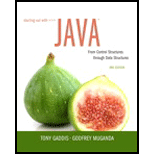
Starting Out with Java: From Control Structures through Data Structures (3rd Edition)
3rd Edition
ISBN: 9780134038179
Author: Tony Gaddis, Godfrey Muganda
Publisher: PEARSON
expand_more
expand_more
format_list_bulleted
Question
Chapter 17, Problem 2SA
Program Plan Intro
Sequential search:
- The sequential search
algorithm is the process to find an item in an array. - It compares each value and searching starts at the beginning of the array.
- In the searching process, the algorithm compares each item in an array and finds an item.
Expert Solution & Answer
Want to see the full answer?
Check out a sample textbook solution
Students have asked these similar questions
Write the SQL code that permits to implement the tables: Student and Transcript. NB: Add the constraints on the attributes – keys and other.
Draw an ERD that will involve the entity types: Professor, Student, Department and Course. Be sure to add relationship types, key attributes, attributes and multiplicity on the ERD.
Draw an ERD that represents a book in a library system. Be sure to add relationship types, key attributes, attributes and multiplicity on the ERD.
Chapter 17 Solutions
Starting Out with Java: From Control Structures through Data Structures (3rd Edition)
Ch. 17.1 - Prob. 17.1CPCh. 17.1 - Prob. 17.2CPCh. 17.1 - Prob. 17.3CPCh. 17.1 - Prob. 17.4CPCh. 17.2 - Prob. 17.5CPCh. 17.2 - Prob. 17.6CPCh. 17.2 - Prob. 17.7CPCh. 17.2 - If a sequential search is performed on an array,...Ch. 17.3 - Prob. 17.9CPCh. 17.3 - Prob. 17.10CP
Ch. 17.3 - Prob. 17.11CPCh. 17.3 - Prob. 17.12CPCh. 17.3 - Prob. 17.13CPCh. 17.3 - Prob. 17.14CPCh. 17.3 - Let a[ ] and b[ ] be two integer arrays of size n....Ch. 17.3 - Prob. 17.16CPCh. 17.3 - Prob. 17.17CPCh. 17.3 - Prob. 17.18CPCh. 17 - Prob. 1MCCh. 17 - Prob. 2MCCh. 17 - Prob. 3MCCh. 17 - Prob. 4MCCh. 17 - Prob. 5MCCh. 17 - Prob. 6MCCh. 17 - Prob. 7MCCh. 17 - Prob. 8MCCh. 17 - Prob. 9MCCh. 17 - Prob. 10MCCh. 17 - True or False: If data is sorted in ascending...Ch. 17 - True or False: If data is sorted in descending...Ch. 17 - Prob. 13TFCh. 17 - Prob. 14TFCh. 17 - Assume this code is using the IntBinarySearcher...Ch. 17 - Prob. 1AWCh. 17 - Prob. 1SACh. 17 - Prob. 2SACh. 17 - Prob. 3SACh. 17 - Prob. 4SACh. 17 - Prob. 5SACh. 17 - Prob. 6SACh. 17 - Prob. 7SACh. 17 - Prob. 8SACh. 17 - Prob. 1PCCh. 17 - Sorting Objects with the Quicksort Algorithm The...Ch. 17 - Prob. 3PCCh. 17 - Charge Account Validation Create a class with a...Ch. 17 - Charge Account Validation Modification Modify the...Ch. 17 - Search Benchmarks Write an application that has an...Ch. 17 - Prob. 8PCCh. 17 - Efficient Computation of Fibonacci Numbers Modify...
Knowledge Booster
Similar questions
- 2:21 m Ο 21% AlmaNet WE ARE HIRING Experienced Freshers Salesforce Platform Developer APPLY NOW SEND YOUR CV: Email: hr.almanet@gmail.com Contact: +91 6264643660 Visit: www.almanet.in Locations: India, USA, UK, Vietnam (Remote & Hybrid Options Available)arrow_forwardProvide a detailed explanation of the architecture on the diagramarrow_forwardhello please explain the architecture in the diagram below. thanks youarrow_forward
- Complete the JavaScript function addPixels () to calculate the sum of pixelAmount and the given element's cssProperty value, and return the new "px" value. Ex: If helloElem's width is 150px, then calling addPixels (hello Elem, "width", 50) should return 150px + 50px = "200px". SHOW EXPECTED HTML JavaScript 1 function addPixels (element, cssProperty, pixelAmount) { 2 3 /* Your solution goes here *1 4 } 5 6 const helloElem = document.querySelector("# helloMessage"); 7 const newVal = addPixels (helloElem, "width", 50); 8 helloElem.style.setProperty("width", newVal); [arrow_forwardSolve in MATLABarrow_forwardHello please look at the attached picture. I need an detailed explanation of the architecturearrow_forward
- Information Security Risk and Vulnerability Assessment 1- Which TCP/IP protocol is used to convert the IP address to the Mac address? Explain 2-What popular switch feature allows you to create communication boundaries between systems connected to the switch3- what types of vulnerability directly related to the programmer of the software?4- Who ensures the entity implements appropriate security controls to protect an asset? Please do not use AI and add refrencearrow_forwardFind the voltage V0 across the 4K resistor using the mesh method or nodal analysis. Note: I have already simulated it and the value it should give is -1.714Varrow_forwardResolver por superposicionarrow_forward
- Describe three (3) Multiplexing techniques common for fiber optic linksarrow_forwardCould you help me to know features of the following concepts: - commercial CA - memory integrity - WMI filterarrow_forwardBriefly describe the issues involved in using ATM technology in Local Area Networksarrow_forward
arrow_back_ios
SEE MORE QUESTIONS
arrow_forward_ios
Recommended textbooks for you
- Programming Logic & Design ComprehensiveComputer ScienceISBN:9781337669405Author:FARRELLPublisher:Cengage
 Microsoft Visual C#Computer ScienceISBN:9781337102100Author:Joyce, Farrell.Publisher:Cengage Learning,
Microsoft Visual C#Computer ScienceISBN:9781337102100Author:Joyce, Farrell.Publisher:Cengage Learning, EBK JAVA PROGRAMMINGComputer ScienceISBN:9781337671385Author:FARRELLPublisher:CENGAGE LEARNING - CONSIGNMENT
EBK JAVA PROGRAMMINGComputer ScienceISBN:9781337671385Author:FARRELLPublisher:CENGAGE LEARNING - CONSIGNMENT  C++ Programming: From Problem Analysis to Program...Computer ScienceISBN:9781337102087Author:D. S. MalikPublisher:Cengage Learning
C++ Programming: From Problem Analysis to Program...Computer ScienceISBN:9781337102087Author:D. S. MalikPublisher:Cengage Learning New Perspectives on HTML5, CSS3, and JavaScriptComputer ScienceISBN:9781305503922Author:Patrick M. CareyPublisher:Cengage Learning
New Perspectives on HTML5, CSS3, and JavaScriptComputer ScienceISBN:9781305503922Author:Patrick M. CareyPublisher:Cengage Learning Programming with Microsoft Visual Basic 2017Computer ScienceISBN:9781337102124Author:Diane ZakPublisher:Cengage Learning
Programming with Microsoft Visual Basic 2017Computer ScienceISBN:9781337102124Author:Diane ZakPublisher:Cengage Learning

Programming Logic & Design Comprehensive
Computer Science
ISBN:9781337669405
Author:FARRELL
Publisher:Cengage

Microsoft Visual C#
Computer Science
ISBN:9781337102100
Author:Joyce, Farrell.
Publisher:Cengage Learning,

EBK JAVA PROGRAMMING
Computer Science
ISBN:9781337671385
Author:FARRELL
Publisher:CENGAGE LEARNING - CONSIGNMENT

C++ Programming: From Problem Analysis to Program...
Computer Science
ISBN:9781337102087
Author:D. S. Malik
Publisher:Cengage Learning

New Perspectives on HTML5, CSS3, and JavaScript
Computer Science
ISBN:9781305503922
Author:Patrick M. Carey
Publisher:Cengage Learning

Programming with Microsoft Visual Basic 2017
Computer Science
ISBN:9781337102124
Author:Diane Zak
Publisher:Cengage Learning